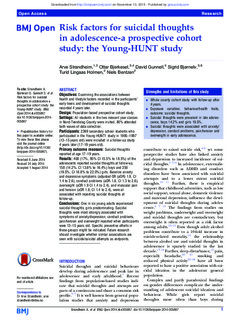| dc.contributor.author | Strandheim, Arve | |
| dc.contributor.author | Bjerkeset, Ottar | |
| dc.contributor.author | Gunnell, David | |
| dc.contributor.author | Bjørnelv, Sigrid | |
| dc.contributor.author | Holmen, Turid Lingaas | |
| dc.contributor.author | Bentzen, Niels | |
| dc.date.accessioned | 2015-11-10T11:36:49Z | |
| dc.date.accessioned | 2015-11-23T14:25:43Z | |
| dc.date.available | 2015-11-10T11:36:49Z | |
| dc.date.available | 2015-11-23T14:25:43Z | |
| dc.date.issued | 2014 | |
| dc.identifier.citation | BMJ Open 2014, 4(8) | nb_NO |
| dc.identifier.issn | 2044-6055 | |
| dc.identifier.uri | http://hdl.handle.net/11250/2365343 | |
| dc.description.abstract | Objectives: Examining the associations between health and lifestyle factors recorded in the participants’ early teens and development of suicidal thoughts recorded 4 years later.
Design: Population-based prospective cohort study.
Settings: All students in the two relevant year classes in Nord-Trøndelag County were invited, 80% attended both waves of data collection.
Participants: 2399 secondary school students who participated in the Young-HUNT1 study in 1995–1997 (13–15 years old) were included in a follow-up study 4 years later (17–19 years old).
Primary outcome measure: Suicidal thoughts reported at age 17–19 years.
Results: 408 (17%, 95% CI 15.5% to 18.5%) of the adolescents reported suicidal thoughts at follow-up, 158 (14.2%, CI 13.6% to 16.4%) boys and 250 (19.5%, CI 18.8% to 22.0%) girls. Baseline anxiety and depressive symptoms (adjusted OR (aOR) 1.9, CI 1.4 to 2.6), conduct problems (aOR 1.8, CI 1.3 to 2.6), overweight (aOR 1.9 CI 1.4 to 2.4), and muscular pain and tension (aOR 1.8, CI 1.4 to 2.4), were all associated with reporting suicidal thoughts at follow-up.
Conclusions: One in six young adults experienced suicidal thoughts, girls predominating. Suicidal thoughts were most strongly associated with symptoms of anxiety/depression, conduct problems, pain/tension and overweight reported when participants were 13–15 years old. Specific preventive efforts in these groups might be indicated. Future research should investigate whether similar associations are seen with suicide/suicidal attempts as endpoints. | nb_NO |
| dc.language.iso | eng | nb_NO |
| dc.publisher | BMJ Publishing Group | nb_NO |
| dc.relation.uri | http://bmjopen.bmj.com/content/4/8/e005867.full.pdf+html | |
| dc.title | Risk factors for suicidal thoughts in adolescence-a prospective cohort study:the Young-HUNT study | nb_NO |
| dc.type | Journal article | nb_NO |
| dc.type | Peer reviewed | en_GB |
| dc.date.updated | 2015-11-10T11:36:49Z | |
| dc.source.volume | 4 | nb_NO |
| dc.source.journal | BMJ Open | nb_NO |
| dc.source.issue | 10 | nb_NO |
| dc.identifier.doi | 10.1136/bmjopen-2014-005867 | |
| dc.identifier.cristin | 1194190 | |
| dc.description.localcode | This is an Open Access article distributed in accordance with the Creative Commons Attribution Non Commercial (CC BY-NC 4.0) license, which permits others to distribute, remix, adapt, build upon this work non-commercially, and license their derivative works on different terms, provided the original work is properly cited and the use is non-commercial. See: http://creativecommons.org/licenses/by-nc/4.0/ | nb_NO |
